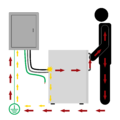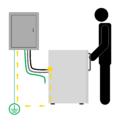Residual current device
A residual current device (RCD) or Ground Fault Circuit Interruptor (GFCI) is a device that constantly measures the current flowing between the outgoing and incoming wires of a circuit to see if there is a difference. If there is a difference, it means that there is a fault at some point in the circuit and a potential hazard. A RCD is typically incorporated into a breaker or outlet so that it is able to disconnect the circuit upon identifying a difference in current or fault. RCDs are often required by the electrical codes in many countries. In a grounded system this current is typically returning through the grounding system. RCDs are far more effective at preventing electrical accidents than OCPDs as they are far more sensitive and can therefore identify hazards more easily. All RCDs should include a test button (pictured in yellow in the diagram) that enables users to periodically make sure the device is functioning correctly.
A small amount of current - .1-.2 amps - can be sufficient for an electric shock to be lethal, yet the overcurrent protection devices installed in electrical systems for lighting and outlets are generally 15 amps or more. Additionally, overcurrent protection devices typically have a time delay to avoid accidentally opening (disconnecting) the circuit if there is a brief surge of current required by a surge load. If there is insufficient current flowing to activate the overcurrent protection device, this can lead to a many faults and potential hazards going unnoticed until there is an accident. An RCD is far more sensitive - can be activated by as little as 5-30mA (.005-.03 A) of current - and will activate within 25-40ms (.025-.04 seconds). It is recommended that a RCD be incorporated into any system that has an grounding system on the alternating current (AC) side incorporate a RCD to improve the safety of an off-grid installation.
Functioning of an RCD
An RCD works best relative to an OCPD in cases where there is a poor (high resistance) ground connection or no equipment ground for an appliance. In the example below a refrigerator is depicted with a loose/non-existant ground. There is a fault on L1 (ungrounded conductor) inside the refrigerator which is leaking some current to ground, but not enough to trigger an overcurrent protection device or to cause the refrigerator to stop working.
- Example 1: If the system does not have an RCD then the small amount of current flowing through ground will go undetected until a lower resistance path to ground is created, which in the example is created when a person touches the refrigerator. A larger amount of current now flows through the person to ground and may trigger overcurrent protection device but not without electrocuting the person first.
- Example 2: If the system has an RCD then the small amount of current flowing through ground will be quikcly detected and the fault/hazard will be mitigated by opening (disconnecting) the circuit. The refrigerator will stop functioning, but a person will be able to safely touch it without being electrocuted.


